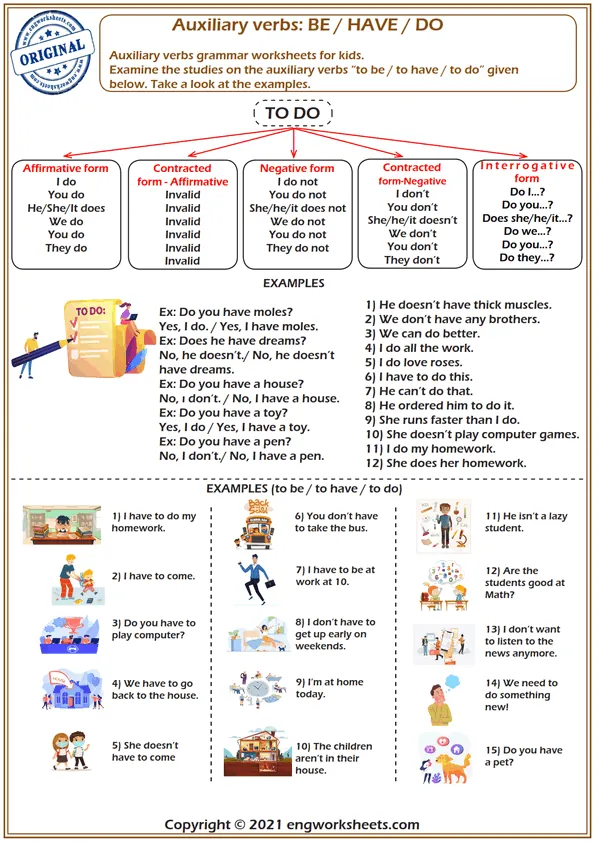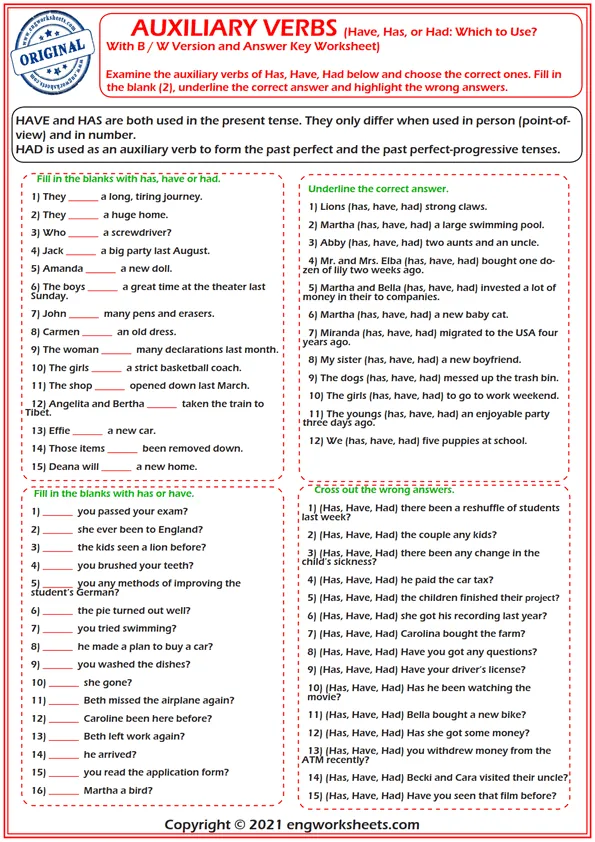
Auxiliary Verbs Grammar Worksheets For Kids.
Auxiliary Verbs Grammar For Kids Esl Printable Worksheets And Examples Free Esl Printable Grammar Worksheets For Kids, Eal Exercises, Esol Quizzes, Efl Questions, Tefl Handouts, Elt Activities, English Learning And Teaching Resources, Multiple Choice Tests. Information, Rules And Examples For Kids About Auxiliary Verbs An Auxiliary Verb Helps The Main Full Verb And Is Also Called A "helping Verb." With Auxiliary Verbs, You Can Write Sentences In Different Tenses, Moods, Or Voices. Auxiliary Verbs Are: Be, Do, Have, Will, Shall, Would, Should, Can, Could, May, Might, Must, Ought, Etc. Auxiliary Verbs Are Very Important For The Correct Understanding Of A Sentence. An Auxiliary Verb That Is Not Used Correctly Affects The Meaning Of The Sentence Negatively And Can Lead To Different Meanings. A Correctly Used Auxiliary Verb Makes The Sentences Understandable By Ensuring The Correct And Proper Understanding Of The Sentence. In This Worksheet, You Will Find Useful Information And Examples Of Modal Verbs "to Be / To Have / To Do". Examine The Studies On The Auxiliary Verbs “To Be / To Have / To Do†Given Below. Take A Look At The Examples. Auxiliary Verbs Exercises, Auxiliary Verbs In English, Auxiliary Verbs Examples, Auxiliary Verbs List, Auxiliary Verbs Exercises Pdf, Auxiliary Verbs Test, Auxiliary Verbs Questions, Auxiliary Verbs Grammar, Auxiliary Verbs Worksheets, Auxiliary Verbs Grammar Worksheets.

Auxiliary Verbs Has Have Had Esl Exercises Worksheet
Auxiliary Verbs Has Have Had Esl Exercises Worksheet An Esl Grammar Exercises Worksheet For Kids To Study And Practice The Auxiliary Verbs Was, Were, And Did. Complete The Reading Text With Has, Have, Had. Read The Sentences And Fill In The Blanks With Has , Have, Had. Choose The Correct Alternative. Cross The Others. An Esl Worksheet For Kids To Study And Practice The Auxiliary Verbs Has, Have, Had For Present Perfect Tense. Fill In The Blanks And Complete The Sentences Using The Correct Auxiliary Verb. Have, Has, Or Had: Which To Use? With B / W Version And Answer Key Worksheet. In This Article, We’Ll Focus On The Verbs Has, Have, And Had. They All Show Possession And Are Either Used As A Transitive Verb Or As An Auxiliary Verb. Auxiliary Verbs Or Helping Verbs Assist The Main Verb. In This Case, Has, Have, And Had Help With The Tenses. Have And Has Are Both Used In The Present Tense. They Only Differ When Used In Person Point-Of-View And In Number. Had Is Used As An Auxiliary Verb To Form The Past Perfect And The Past Perfect-Progressive Tenses. Has Have Had Worksheet, Has Have Had Worksheets With Answers Pdf, Has Have Had Worksheet For Class 2 With Answers, Has Have Had Worksheet With Answers, Has Have Had Worksheet For Class 4, Has Have Had Worksheet For Class 3 With Answers, Has Have Had Worksheets Pdf, Has Have Had Worksheet For Class 5, Has Have Had Worksheet For Grade 3 Has Have Had Grammar, Has Have Had Grammar Rules, Has Have Had Grammar Exercises, Has Have Had Grammar Rules Examples.

Auxiliary Verbs Must Or Mustn't Esl Exercise Worksheet For Kids
Auxiliary Verbs Must Or Mustn't Esl Exercise Worksheet For Kids An Enjoyable Esl Exercise Worksheet For Kids To Study And Practice Must And Mustn't. We Can Use 'must' To Talk About Rules. For The Negative, We Can Say 'must Not' Or 'mustn't'. Many Learners Confuse How To Use The Words ‘Must’ And ‘Mustn’T’ In English. While They Might Seem Tricky, They Are Actually Quite Simple To Use. ‘Must’ Is A Modal Verb, Which Means It Does Not Show Action Like Most Verbs. Look At The Pictures. Read The Sentences And Fill In The Blanks With Must Or Mustn't. Must Or Mustn't, Must And Mustn't Exercises, Mustn't Activities, Mustn't Worksheet, Mustn't Exercise Pdf, Mustn't Examples, Must And Have To Exercises.

Auxiliary Verbs Did, Didnt, Do, Does, Dont, Doesnt Esl Exercise Worksheet For Kids
Complete The Following Sentences By Using The Correct Form Of To Do Do, Don't, Does, Doesn't, Did, Didn't . The Words "do", "don't", "does" And "doesn't" Appear A Lot In English. In Making Affirmatives Statements: Do / Don't / Does / Doesn't Comes After The Subject. In Asking Questions: Do / Don't / Does / Doesn't Come Before The Subject. Auxiliary Verb - Do - Don´t - Does - Doesn´t - Did. We Sometimes Use The Verb Do To Replace A Verb When The Meaning Is Clear Or Obvious. To Make A Question In The Simple Present Tense In English We Normally Put The Auxiliary Do Or Does At The Beginning Of The Question Before The Subject. To Make A Question In The Past Tense In English We Normally Put The Auxiliary Did At The Beginning Of The Question Or Before The Main Subject. When To Use Did Not And Does Not? Did Doesn't Doesn't? Did Or Didn't Do? Did Not Go Or Did Not Went?do Does Did Don’T Doesn’T Didn’T, Do Does Did Don’T Doesn’T Didn’T Exercises, Do Does Did Don’T Doesn’T Didn’T Worksheets, Did Didn't Worksheet, Esl Did Didn't Worksheet, Past Continuous Exercises, Present Continuous Exercises, Possessive Adjectives Exercises Past Continuous Tense Exercises, Past Perfect Exercises, Some Any Exercises, Future Tenses, Present Continuous Worksheet, Past Continuous Tense Exercise, Word Order.

The Verb To Do As An Auxiliary And A Main Verb, Do As A Phrasal Verb With Meanings And Examples And Collocations With Do
The Verb To Do As An Auxiliary And A Main Verb, Do As A Phrasal Verb With Meanings And Examples And Collocations With Do
